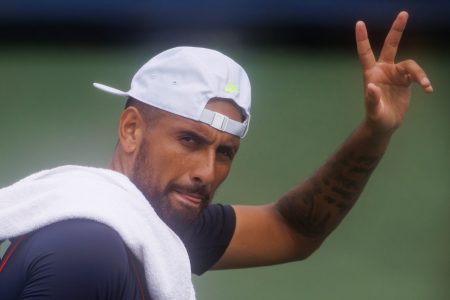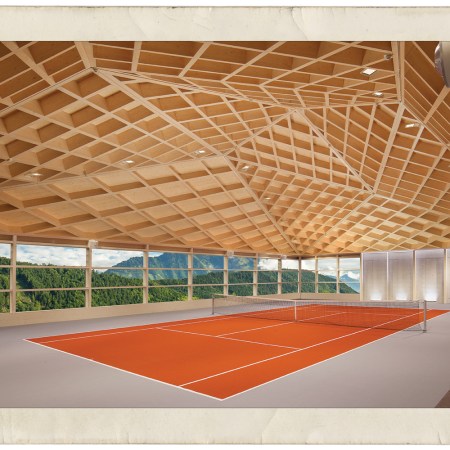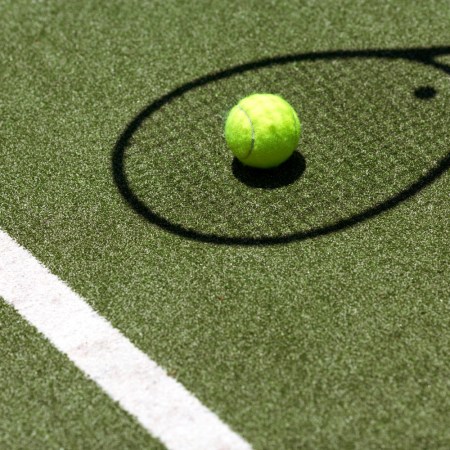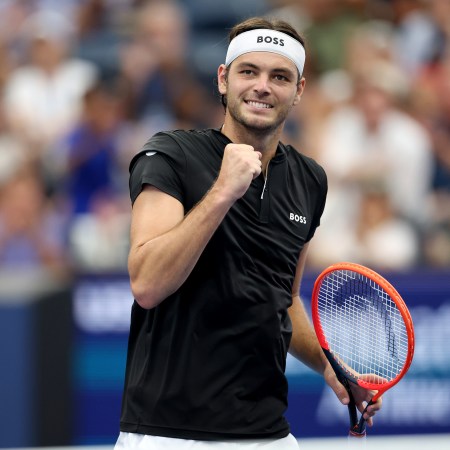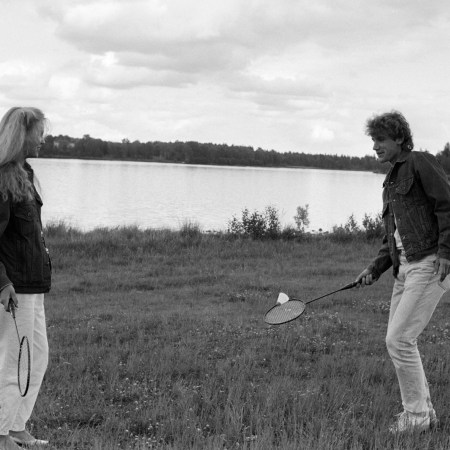For 100 bucks, 2023 NCAA Division I tennis champ Ethan Quinn will help you fix your forehand. Four months ago, the 19-year-old, originally from Fresno, California, finished his first and only season with the University of Georgia Bulldogs by besting a French Open boy’s doubles winner and countless other former junior greats, all as a true freshman. And after returning home, with input from his parents and childhood coach, he made the decision to forego his remaining NCAA eligibility and turn pro, which means he can now teach 45-minute tennis lessons, shout-out businesses and sell autographed photos, along with a suite of other services that would normally run afoul of college sports regulations.
“If you don’t repeat, you’re going to be just another guy who won an NCAA and it didn’t work out,” Quinn says. “After three years of wanting to be a professional tennis player, there was no hesitancy.” With a wild card into the main draw of the US Open, which runs from August 28 to September 10 in Flushing Meadows, the teen has lofty goals of which he hadn’t dreamed a year ago. He’s not alone: This year, he joins a significant number of players across the world and within the U.S. who are making an oversized impact despite their youth.
Rafa Nadal. Roger Federer. Novak Djokovic. The epoch of the Big Three, as they’ve been known over the past 20 years, is coming to an end. Federer, 42, officially retired in 2022 after spending much of the previous year injured. Nadal, 37, is currently injured and has already announced that a 2024 season will be his last. And while Djokovic, 36, won the Australian Open and French Open tournaments in 2023, he’s currently locking horns with a 20-year-old Spanish prodigy named Carlos Alcaraz, who bested him at the Wimbledon Championships in July.
In normal times, when seniors graduate, the juniors take their lockers. But over the past two years, a gang of pimple-faced freshmen have been cutting in front of the upperclassmen. Alcaraz, with 12 titles to date (and two majors, including the 2022 US Open), is just the most widely known example. There’s also Holger Rune, a 20-year-old Dane, fourth in the world, and Italy’s Jannik Sinner, who just turned 22, in sixth. Seemingly each month a new teen sensation seems to rise from obscurity to tear chunks from the flanks of an aging herd.
Domestically, American men are also part of this trend, including 20-year-old Ben Shelton, a second-generation tennis standout who made the quarter-finals of the Australian Open this year, his first as a pro. Most recently, 18-year-old Alex Michelsen, a high schooler committed to UGA this fall, went on an out-of-nowhere run to the finals at the 2023 Hall of Fame Open, a pro tournament in Newport in July. Unsurprisingly, Michelsen, who has also received a wild card to the 2023 US Open, announced his decision to turn pro less than a month later.
To be clear, the NCAA system has, historically and currently, produced great American pro players. Former world number eight John Isner, another UGA alum, spent four years in school, and currently four of the eight Americans in the top 50 have at least a year of NCAA experience, with two — Mackenzie McDonald and Shelton — achieving NCAA singles titles. But more often, rather than enjoying a full collegiate career, American pros spend a year or two in the system before electing to move on into the real world, while a significant number, including current world No. 9 Taylor Fritz, No. 10 Frances Tiafoe and No. 14 Tommy Paul, skip college entirely, begging the question why some choose to enter academia while others elect the LeBron-Kobe route to the big stage.
Here there emerges a clear dichotomy between men and women, the latter of whom have, historically, burst onto the scene at ages which even gifted students would be unlikely to matriculate. According to legendary coach Rick Macci, the men’s game is more physical than the women’s game, with a special importance on the serve, which averages around 120 miles per hour and can top off around 140. (Can a junior hit 120? Certainly. But can he hit it 10 times in a row? Less likely.)
And then there’s the movement of the men’s game itself. “Like pinball on steroids,” Macci says. “The girls, it’s still difficult, but it’s not as physical. It just takes longer for the guys to get in there and make their mark.” As the former coach of Serena Williams, Maria Sharapova, Venus Williams and Jennifer Capriati (the latter two of whom were already achieving pro results at 14), he would know firsthand.
Backing this logic, studies have shown that boys typically hit puberty two years later than girls, creating a lag in physical development compared to their opposite-gendered peers. (Vanderbilt men’s tennis coach Scott Brown, who has coached junior boys and girls, disagrees about the differing characteristics between the men’s and women’s games: “It’s a brutal sport, whether it’s male or female,” he says.) For whatever reason, historically, breakout teen boys are much rarer than breakout teen girls.
Beyond the physical limitations, there’s also the general cost of playing professional tennis, an international sport rife with wallet-draining necessities. Court fees, coaching, physical therapy, plane tickets, hotels, food, apparel and shoes, equipment and a host of other line items add up as a player gets his feet wet, making it financially impossible for all but those of independent wealth or with deep-pocketed backers. Like an easy mark at a casino, once your money is gone, it’s gone, and then the hard times kick in. “No guy’s just going to jump in there and just start knocking guys out,” Macci says. “You’re going to lose a lot in the first round.”
Like His Beloved Boston Celtics, Nick Kyrgios Is Close to Breaking Through
Kyrgios came up just short against Novak Djokovic at Wimbledon and is looking to keep the momentum going in QueensFor those who choose college as a midpoint to the pros, both costs and maturation are a huge part of it. “[College] can provide the resources that the Djokovics and the Nadals have,” Brown, himself a former standout NCAA player, says. The vast majority of expenses, along with facilities, are covered by the school, with zero cost to the student. “The schools are basically paying you to come there,” he continues. “It’s free development.” Add to that the value of a college degree — after all, eventually all tennis players retire — and, “It’s a package that’s tough to beat.”
So the question for aspirant pros becomes where you want to lose a lot. As you pack on muscle, refine your game and learn the lifestyle of the Association of Tennis Professionals Tour, you can choose a dingy European hotel, which has provided sad pastries that don’t agree with your stomach, and exit in round one. Or you can lose while staying in your dorm, surrounded and supported by your teammates, who will invite you to dinner following. Even Quinn, who started his Cinderella season on shaky ground and uncharacteristic losses, credits the Georgia team environment for getting him back to winning form. “They were able to continue pushing me every single day, knowing that I was going through this really difficult time,” he says. “Without them, I don’t know where I would have been.”
“You learn how to play for something bigger than yourself,” Brown says. “I think that applies to the Tour.”
Now 40, Wkwesi Williams knew in high school that he wanted to play professional tennis. But he also knew his route would take him through college. “It wasn’t two paths for me. There was only one path,” Williams says. “You’re going to go to college, and after college, you’re going to use that.”
Part of Williams’s decision to attend the University of California at Irvine was based on development: Starting relatively late at 11, his peers had already been playing for six years or more. The coaching he received in college added dimensions to his game, which bore fruit during three years on the pro circuit and representing his native Barbados in the Davis Cup tournament. It also let him enjoy the sport more because of the reduced financial burden on his parents. “Emotionally and mentally, you feel better, because you don’t feel like they’re sacrificing as much as they were before,” he says.
But now, long since he officially retired from competitive sport, Williams credits the experience largely for the relationships he formed in the process. He still thinks back fondly on Thailand tournaments spent with his Sri Lankan college teammate. “That wouldn’t have happened, because I wouldn’t have known him,” he says.
“I’m still benefitting from the sport,” Williams, a member of the Wilson Advisory Staff and tennis instructor, continues. “It’s still giving me so much. I have no regrets at all.”
The question, then, is why so many young men around the world — and in the U.S. — are stepping up to the professional levels early, and why they’re doing it now. First, take Alcaraz out of the picture. “He’s Federer, Nadal, Djokovic and Agassi all wrapped in one,” Macci says. “I don’t think you can compare anybody to that guy.” But asking Macci and Brown why teenagers are, more and more often, running the ship, and there’s no clear answer.
Some of this can be cyclical. Andre Agassi and Pete Sampras both turned pro at 16 within two years of each other in the ‘80s, while Andy Roddick, the last American to win a Grand Slam and another of Macci’s students, won his first pro match at 17 in 2000. Explaining why individuals can suddenly break out, as with Shelton at the Australian Open this year, Macci speculates a sudden growth spurt packs on enough muscle to marry the technical development already in place. “When you can hit a serve 147 miles an hour, you’ve got a shot against anybody,” he says.
Brown, from his decade-plus of coaching collegiate and juniors, says it’s hard to point to any one reason for why now. There haven’t been significant advancements in equipment or training philosophy. In the end, it comes down to the stars aligning. “These are physical specimens that just have that innate gift,” he says. “They were meant to be tennis players. I don’t want to call them freaks, but they’re freaks in a good way.” And then he laughs as only a former tennis player can. “I wasn’t that kind of freak.”
Whether you’re looking to get into shape, or just get out of a funk, The Charge has got you covered. Sign up for our new wellness newsletter today.

